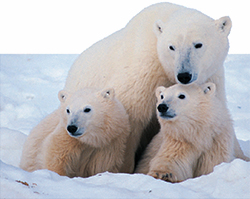Handling an encounter
Wapusk National Park
PDF document: Safety in polar bear country (PDF, 1.1 MB)
Polar bears are the largest land carnivore in North America. An adult male typically weighs 300 to 450 kilograms, stretching three metres from nose to tail. They are strong, fast, agile on land or ice and are expert swimmers and divers. Their sense of smell is exceptional, and their eyesight comparable to a human’s. Polar bears are naturally curious, but not fearless as they have been labelled. They are shy and prefer to avoid confrontations with humans and other polar bears. Their primary prey is the ringed seal but they will also prey on birds, eggs, small mammals and even humans. They also scavenge anything from beached whales to human garbage. In the heat of summer, polar bears may appear slow and docile, but they are capable of moving swiftly and with purpose.
Before your trip, discuss possible plans of action for dealing with bears in a variety of circumstances and be sure everyone understands. The actions of each individual either contribute to or detract from the safety of everyone else.
Every attack or encounter is different. To find out more about bear behaviour, hire a guide or talk to knowledgeable people in the community.
Stay calm, notify everyone in the group, be aware of your surroundings and assess the situation. What is the bear doing? What is the bear’s behaviour?
If a bear does not know you are there:
- quietly back away and leave the area either in the direction you came or make a wide detour around the bear. Do not run, move quickly or make motions that might attract the bear’s attention.
- stay downwind, so the bear cannot smell you and detect your presence.
- keep an eye on the bear.
If a bear knows you are there and shows signs of being curious, such as:
- moving slowly with frequent stops,
- standing on hind legs and sniffing the air,
- holding its head high with ears forward or to the side,
- moving its head from side to side, or
- trying to catch your scent by circling downwind and approaching from behind.
then:
- help it to identify you as a human,
- wave your arms over your head and talk in low tones,
- move slowly upwind of the bear so it can get your scent.
If the bear has been surprised at close range or shows signs of being agitated or threatened, such as:
- huffing, panting, hissing, growling or jaw-snapping,
- stamping its feet,
- staring directly at a person, or
- lowering its head with ears laid back.
then:
- act non-threatening. Do not shout or make sudden movements, which might provoke the bear. Never huff or hiss as this can cause a polar bear to charge.
- avoid direct eye contact.
- back away slowly. DO NOT RUN.
- be prepared to use deterrents.
If the bear shows signs of stalking or hunting you, such as:
- following you or circling you,
- approaching directly, intently and unafraid,
- returning after being scared away, or
- appears wounded, old or thin.
then:
- fight back! Use any potential weapon, group together and make loud noises.
- DO NOT RUN.
- be prepared to use deterrents.
If a bear charges:
- stand your ground and be prepared to fight! Focus on hitting the bear in sensitive areas, especially the face and nose if possible. Bluff charges are rare.
 Never get between a bear and her cubs.
Never get between a bear and her cubs.© Wayne Lynch
Never get between a bear and her cubs.
If a female with cubs is surprised at close range or separated from her cubs she will likely attack to defend her cubs.
- leave the area immediately.
- stay in a group.
- fight back if she attacks.
Always leave an escape route for the bear.
Carry deterrents and know how to use them.
Deterrents
Reducing the threat posed by a polar bear during an interaction may be difficult. Non-lethal deterrents cannot be depended on to ensure safety. The best way to live safely with bears is to avoid contact with them.
Any potential weapon must be considered, such as skis, poles, rocks, blocks of ice or even knives.
Stay together as a group. This can be a deterrent and actions, such as making noise, jumping, waving arms, throwing things, may help to drive a polar bear away.
Commercial deterrents:
- Noisemakers including air horns, pistol and pen launched bear bangers may scare a bear away.
- Pepper spray is effective against polar bears, but has some limitations. It must be warm enough to atomize and it must be used at close range. Also be aware of wind direction to avoid having the spray blow into your face.
- Know how and when to use these deterrents and practice beforehand.
- Availability of commercial deterrents is limited in the north, most will have to be purchased elsewhere and transported as dangerous goods.
- Portable solar electric fences may deter a bear at your campsite if properly installed and maintained.
- Contact Parks Canada for more information.
Related links
For more information:
Location:Auyuittuq National Park and
Quttinirpaaq National Park
Box 353
Pangnirtung, NU X0A 0R0
Phone number: 867-473-2500
Email address: nunavut.info@pc.gc.ca
Location:Sirmilik National Park
Box 300
Pond Inlet, NU X0A 0S0
Phone number: 867-899-8092
Email address: sirmilik.info@pc.gc.ca
Location:Ukkusiksalik National Park
Box 220
Repulse Bay, NU X0C 0H0
Phone number: 867-462-4500
Email address: ukkusiksalik.info@pc.gc.ca
Location:Torngat Mountains National Park
Box 471
Nain, NL A0P 1L0
Phone number: 1-800-922-1290 or 709-458-2417
Email address:torngats.info@pc.gc.ca
Location:Wapusk National Park
Box 127 Churchill, MB R0B 0E0
Phone number: 204-675-8863
Email address: manitoba@pc.gc.ca
Location:Western Arctic
Ivvavik National Park
Aulavik National Park
Tuktut Nogait National Park
Pingo Canadian Landmark
Box 1840, Inuvik, NT X0E 0T0
Phone number: 867-777-8800
Email address: inuvik.info@pc.gc.ca
- Date modified :